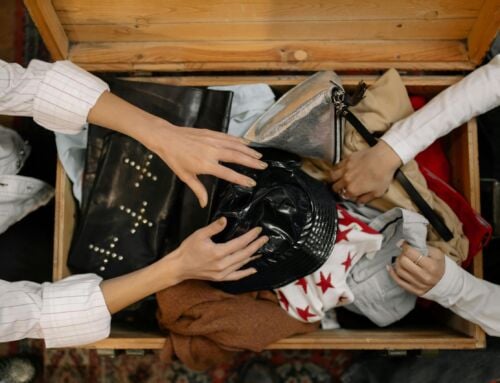Today, the fashion industry faces a major challenge: moving from a linear production model to a circular one. circular economy more environmentally friendly. To achieve this, it is essential to reduce waste, from reduce waste and encourage a more responsible consumption.
Why reduce the impact of the fashion industry?
Today, the linear production model that dominates the fashion industry is based on a simple but problematic pattern: produce, consume, discard. This approach leads to the massive exploitation of natural resources, often to the detriment of ecosystems and local communities, and generates colossal volumes of textile waste. Every year, millions of tons of clothing are sent to landfill or incinerated, even though much of it could be used or recycled. However, easily recycle your clothes and rethinking their use could limit the exploitation of natural resources and reduce waste volumes.
Adopting a circular and sustainable model represents a promising solution to these challenges. This model aims to extend the life of products by promoting reuse, the repair and the recycling. By integrating these practices on a large scale, the industry could significantly reduce its environmental footprint while creating new economic opportunities, particularly in the areas of innovation and employment. At the same time, this transition would have significant social benefits, such as increased consumer awareness of responsible fashion and greater support for local and ethical initiatives.
Initiatives such as those of Refashion highlight the importance of rethink our habits to limit waste and reduce our environmental footprint.
Create, recycle, reuse: the benefits of responsible fashion
One of the most effective ways to limit the environmental impact of fashion is to collect and sort clothes, linens, and shoes. When done correctly, these actions can increase the value of up to 99.7% of articles, thereby reducing waste and saving valuable resources.
For those passionate about design, training courses in Fashion Design Creation offer the opportunity to transform used textiles into unique and eco-friendly items. For example, the upcycling enables the creation of clothing from recycled materials, thereby contributing to a circular economy. Initiatives such as those proposed by The Relay or by local sustainable creation programs guide you through these responsible transformations.
What eco-friendly fashion solutions should we adopt?
There are several recycling methods used in the textile industry and beyond, each playing a vital role in reducing waste and optimizing resources. These techniques, adapted according to materials and objectives, have varying impacts:
- Upcycling : this technique involves transforming materials into products of higher quality or utility. For example, old jeans can be turned into sturdy bags, or fabric scraps can be turned into unique fashion accessories. Upcycling promotes creativity while contributing to a circular economy where waste becomes a valuable resource. Check out workshops such as those offered by Zero Waste France.
- Downcycling : Here, recovered materials are used to make products of lesser quality or value. For example, used textiles can be reduced to fibers for use as stuffing or insulation material. Although this method extends the life of the materials, it can require more energy and reduce the quality of the final product.
- Closed-loop recycling : Recycled materials are used for identical products without any functional alteration, such as PET bottles being turned into new bottles. In textiles, this type of recycling is still in development but shows promise for fibers such as cotton and polyester.
- Open-loop recycling : Recycled material is used for a different purpose. For example, PET plastic bottles can be transformed into fleece fibers for making warm clothing. Although this process expands the possibilities for material recovery, it requires careful management to avoid quality loss or the creation of new waste that is difficult to recycle.
Eco-friendly fashion: how to incorporate sustainability into everyday life
Adopting a sustainable approach to managing our clothing involves several simple but effective actions:
- #Repair : learning how to repair, or have items repaired, extends the life of your clothes. You can also exchange your clothes via platforms such as Vinted or barter events. This limits their premature replacement and reduces the production of new textiles.
- #Reuse Thanks to thrift stores, bartering, and donations, it is possible to give clothing a second life. If an item is no longer useful as is, it can also be transformed. For example, pants can become shorts, and a dress that has become too short can be transformed into a summer top. These simple transformations extend the usefulness of textiles while encouraging creativity.
- #Recycle : There are many recycling solutions that can transform clothing and shoes into new products, whether they are in good condition or worn out. For example, textiles can be transformed into new fibers to make new clothing or insulation materials. Shoes can be recycled to create soles or rubber products. This recycling helps reduce waste and save resources, while supporting the circular economy.
- #Let's reduce Limiting the purchase of new clothes reduces demand for production, which helps preserve natural resources and reduce the amount of textile waste. By taking care of our clothes, washing them at moderate temperatures, or repairing them when necessary, we extend their lifespan and avoid premature disposal. Thus, every item of clothing kept longer contributes to reducing our ecological footprint.
How can you easily recycle your clothes?
Collecting and sorting clothing, as well as complying with certain strict standards regarding composition, are essential to maximizing the potential for textile recycling. However, it is possible to increase the amount of recyclable materials by taking action at the individual level. As citizens, we can contribute by dropping off our unused clothing and shoes at the nearest collection points. This not only frees up space in our closets, but also allows us to actively participate in the reuse of textiles and the reduction of waste.
- Preparing clothes : Make sure clothes are clean and dry before dropping them off. Close the bags (avoid those larger than 30L) and tie shoes together in pairs to simplify sorting.
- Appropriate drop-off point : Drop off textiles at specific collection points and make sure they are placed inside the container to avoid leaving them exposed. Consult organizations such as Emmaus France to find out which places are suitable.
Tips for optimizing textile recycling
- Give preference to clothing made from a single material, which simplifies recycling.
- Choose simple clothing with as few zippers and buttons as possible to avoid complicated dismantling.
- Have a textile recycling bin for items that are beyond repair and create a space for items to give away or sell.
- Keep the labels of your clothes, they make sorting and recycling easier.
By integrating recycling and upcycling practices, the fashion industry can become a eco-friendly fashion solution while significantly reducing its impact on the planet. As consumers, we have a key role to play by adopting simple measures to extend the life of our clothes and limit waste.
Recycle, reuse, and transforming our textiles are not only responsible solutions, but also ways to actively participate in creating a more sustainable future.




